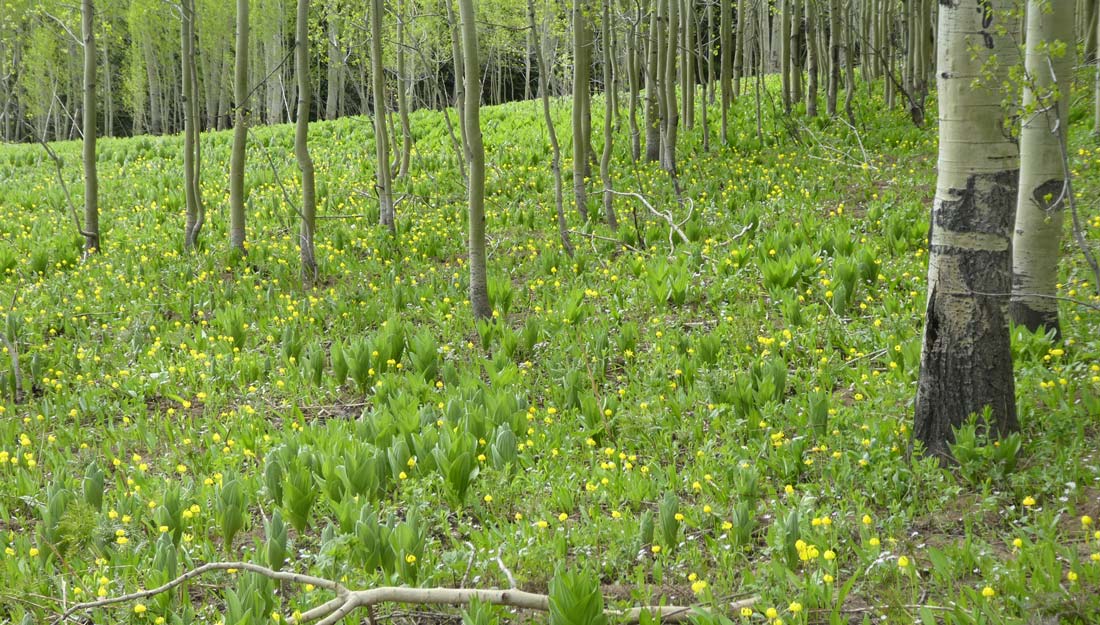Rocky Mountain Aspen Forest and Woodland
Flatops Wilderness near Dunkley Pass, Rio Blanco County
Aspen Forest
Aspen (Populus tremuloides) forests are widely distributed throughout the foothills and montane zones of the Colorado Rockies, from 6,500’ to 11,500’, especially on sandy and gravelly soils. Populus tremuloides’ common name is “quaking aspen”, because its leaves are specially designed to flutter in the wind due to their flat, thin stems. Some botanists theorize that the fluttering action results in greater ability to photosynthesize. In addition, aspens have bark that has 30-50% of the photosynthetic capability as its leaves.
A stand of aspen trees is actually one giant organism, a large clonal colony which has reproduced from a single seed and spread by root suckers. When the sun falls on earth and warms the soil, it stimulates the clone to send up suckers which become full-grown trees. So what looks like a stand of individual trees, is actually one genetic individual which can cover hundreds of acres and weigh thousands of tons. In fact aspen clonal colonies are Colorado’s largest living organism.
Individual clones can often be distinguished from one another in the fall when the leaves take on their fall colors. You will see that one part of the forest has orange leaves, where an adjoining patch may have slightly more yellow leaves.
The largest aspen grove in Colorado, and one of the largest in the United States, is a clone in Kebler Pass, located in the West Elk Mountains near Crested Butte. This clone has been genetically tested and proven to be one genetic individual which has grown from a single seed.
The aspen grove in the photo above is located on a small forest road near Dunckey Pass and Chapman Reservoir in the Routt National Forest at 9,439 feet altitude. The photo was taken in early June when the Avalanche Lilies were in full bloom and carpeted the forest floor.
Some Commonly Associated Plants
Click on photo to see full-page lightbox image.
In lightbox, click on X in upper right corner to return here.
Avalanche Lily (Erythronium grandiflorum ssp. grandiflorum)
Aspens are Colorado’s most widespread deciduous tree covering 5 million acres and accounting for roughly 20% of the state’s forests. Aspens are sun-loving trees, which are early succession colonizers that spread via seed as well as suckers and are able to re-sprout after fire. Stands of aspen are maintained by stand-replacing disturbance from crown fires, insect outbreaks or avalanches. In many areas of Colorado today, you can see robust stands of aspens growing in areas which were formerly lodgepole pine forests, devastated by bark beetle outbreaks. But without disturbances, aspen forests are often replaced by conifers over time.
In the 21st century Aspen forests in Colorado have suffered significant declines, especially at lower elevations, as a result of drought, disease, overgrazing, and invasion by other tree species.
Since Aspen forests frequently have somewhat dense canopy cover, the understory often consists of shade tolerant shrubs and perennials that include Serviceberry (Amelanchier alnifolia), rose species (Rosa spp.), Chokecherry (Prunus virginiana), Oregon grape (Berberis repens), sedges (Carex spp, and mountain strawberry (Fragaria virginiana), among others. But understory structure may also be complex with multiple layers of shrubs and herbs, or relatively simple herb layers dominated by forb or graminoid species.
– Mo Ewing

